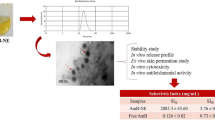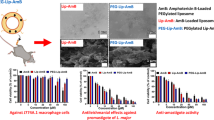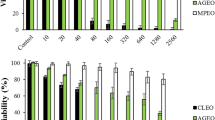Abstract
Cutaneous leishmaniasis being a neglected tropical disease (NTD) faces several challenges in chemotherapy. If infected with secondary bacterial infections, the treatment regime of cutaneous ulcers in cutaneous leishmaniasis is further complicated which usually require two or more than two chemotherapeutic agents for healing. In the current study, seven curcumin-loaded self-emulsifying drug delivery system (cu-SEDDS) formulations (namely F1–F7) were prepared by mixing different excipients (oils, surfactants, and co-solvents) through stirring (vortex) and sonication. The formulations were characterized regarding their droplet size, polydispersity index (PDI), and zeta potential by zeta sizer. The cu-SEDDS formulations displayed different sizes ranging from 32.4 up to 80.0 nm. The zeta potential of the formulations ranged from − 1.56 up to − 4.8. The antileishmanial activities of the cu-SEDDS formulations in terms of IC50 against Leishmania tropica ranged from 0.19 up to 0.37 μg/ml. The minimum inhibitory concentrations (MICs) of these formulations against Escherichia coli, Pseudomonas aeruginosa, Staphylococcus aureus, and Klebsiella pneumoniae were in the range of 48–62 μg/ml. The hemolysis caused by formulations was 1–2%. The spreading potential of the formulations (F1 and F5) over damaged skin model was remarkable. These results suggest that cu-SEDDS further enhanced the broad spectrum antileishmanial and antibacterial profile of curcumin and could be used for the treatment of cutaneous leishmaniasis and its associated secondary infections.



Similar content being viewed by others

References
Ahmad J, Kohli K, Mir SR, Amin S (2012) Self-emulsifying nano carriers for improved oral bioavailability of lipophilic drugs. Rev Adv Sci Eng 1(2):134–147
CLSI (2013) Clinical and Laboratory Standards Institute Standards Development Policies and Processes. CLSI S-001/3.0
Debata PR, Castellanos MR, Fata JE, Baggett S, Rajupet S, Szerszen A, Begum S, Mata A, Murty VV, Opitz LM, Banerjee P (2013) A novel curcumin-based vaginal cream Vacurin selectively eliminates apposed human cervical cancer cells. Gynecol Oncol 129(1):145–153
Dutta A, Bandyopadhyay S, Mandal C, Chatterjee M (2005) Development of a modified MTT assay for screening antimonial resistant field isolates of Indian visceral leishmaniasis. Parasitol Int 54(2):119–122
Ekrami A, Kalantar E (2007) Bacterial infections in burn patients at a burn hospital in Iran. Indian J Med Res 126(6):541
Fontes CO, Carvalho MAR, Nicoli JR, Hamdan JS, Mayrink W, Genaro O, Carmo LS, Farias LM (2005) Identification and antimicrobial susceptibility of micro-organisms recovered from cutaneous lesions of human American Tegumentary leishmaniasis in Minas Gerais, Brazil. J Med Microbiol 54(11):1071–1076
Fouladvand M, Barazesh A, Tahmasebi R (2013) Evaluation of in vitro antileishmanial activity of curcumin and its derivatives “Gallium curcumin, Indium curcumin and Diacethyle curcumin”. Eur Rev Med Pharmacol Sci 17(24):3306–3308
Fricker G, Kromp T, Wendel A, Blume A, Zirkel J, Rebmann H, Setzer C, Quinkert RO, Martin F, Muller-Goymann C (2010) Phospholipids and lipid-based formulations in oral drug delivery. Pharm Res 27(8):1469–1486
Georgiadou SP, Makaritsis KP, Dalekos GN (2015) Leishmaniasis revisited: current aspects on epidemiology, diagnosis and treatment. J Transl Int Med 3(2):43–50
Gunes H, Gulen D, Mutlu R, Gumus A, Tas T, Topkaya AE (2016) Antibacterial effects of curcumin: an in vitro minimum inhibitory concentration study. Toxicol Ind Health 32(2):246–250
Gupta SC, Prasad S, Kim JH, Patchva S, Webb LJ, Priyadarsini IK, Aggarwal BB (2011) Multitargeting by curcumin as revealed by molecular interaction studies. Nat Prod Rep 28(12):1937–1955
Khan M, Nadhman A, Sehgal SA, Siraj S, Yasinzai MM (2018) Formulation and characterization of a self-emulsifying drug delivery system (SEDDS) of curcumin for the topical application in cutaneous and mucocutaneous leishmaniasis. Curr Top Med Chem 18(18):1603–1609
Khan M, Khan I, Nadhman A, Yasinzai M, Shah W (2019) Formulation and characterization of a self-nanoemulsifying drug delivery system of amphotericin B for the treatment of leishmaniasis. IET Nanobiotechnol. https://doi.org/10.1049/iet-nbt.2018.5281
Kollner S, Nardin I, Markt R, Griesser J, Prufert F, Bernkop-Schnurch A (2017) Self-emulsifying drug delivery systems: design of a novel vaginal delivery system for curcumin. Eur J Pharm Biopharm 115:268–275
Maheshwari RK, Singh AK, Gaddipati J, Srimal RC (2006) Multiple biological activities of curcumin: a short review. Life Sci 78(18):2081–2087
Moghadamtousi SZ, Kadir HA, Hassandarvish P, Tajik H, Abubakar S, Zandi K (2014) A review on antibacterial, antiviral, and antifungal activity of curcumin. Biomed Res Int 2014:186864
Moghaddam K, Iranshahi M, Yazdi M, Shahverdi A (2009) The combination effect of curcumin with different antibiotics against Staphylococcus aureus. Int J Green Pharm 3(2):141–3. https://doi.org/10.4103/0973-8258.54906
Nederberg F, Zhang Y, Tan JP, Xu K, Wang H, Yang C, Gao S, Guo XD, Fukushima K, Li L, Hedrick JL, Yang YY (2011) Biodegradable nanostructures with selective lysis of microbial membranes. Nat Chem 3(5):409–414
Nigade PM, Patil SL, Tiwari SS (2012) Self emulsifying drug delivery system (SEDDS): a review. Int J Pharm Bio Sci 2(2):42–52
Pandey A, Gupta RK, Bhargava A, Agrawal B (2011) Antibacterial activities of curcumin bioconjugates. Int J Pharmacol 7:874–879
Parasad EHB, Bhaskar Rao A, Reddy G (2014) Biotransformation of curcumin for improved biological activity and antiproliferative activity on acute HT-29 human cell lines. Indian J Biotechnol 13:324–329
Saleheen D, Ali SA, Ashfaq K, Siddiqui AA, Agha A, Yasinzai MM (2002) Latent activity of curcumin against leishmaniasis in vitro. Biol Pharm Bull 25(3):386–389
Sivasothy Y, Sulaiman SF, Ooi KL, Ibrahim H, Awang K (2013) Antioxidant and antibacterial activities of flavonoids and curcuminoids from Zingiber spectabile Griff. Environ Microbiol 30(2):714–720
Struve C, Krogfelt KA (2004) Pathogenic potential of environmental Klebsiella pneumoniae isolates. Environ Microbiol 6(6):584–590
Tajbakhsh S, Mohammadi K, Deilami I, Zandi K, Fouladvand M, Ramedani E, Asayesh G (2008) Antibacterial activity of Indium curcumin and Indium diacetylcurcumin. Afr J Biotechnol 7(21):3832–3835
van Zuylen L, Karlsson MO, Verweij J, Brouwer E, de Bruijn P, Nooter K, Stoter G, Sparreboom A (2001) Pharmacokinetic modeling of paclitaxel encapsulation in Cremophor EL micelles. Cancer Chemother Pharmacol 47(4):309–318
Walker M, Hulme TA, Rippon MG, Walmsley RS, Gunnigle S, Lewin M, Winsey S (1997) In vitro model(s) for the percutaneous delivery of active tissue repair agents. J Pharm Sci 86(12):1379–1384
Wang Y, Lu Z, Wu H, Lv F (2009) Study on the antibiotic activity of microcapsule curcumin against foodborne pathogens. Int J Food Microbiol 136(1):71–74
Yasinzai M, Khan M, Nadhman A, Shahnaz G (2013) Drug resistance in leishmaniasis: current drug-delivery systems and future perspectives. Future Med Chem 5(15):1877–1888
Zhang H, Yao M, Morrison RA, Chong S (2003) Commonly used surfactant, Tween 80, improves absorption of P-glycoprotein substrate, digoxin, in rats. Arch Pharm Res 26(9):768–772
Ziaei H, Sadeghian G, Hejazi S (2008) Distribution frequency of pathogenic bacteria isolated from cutaneus leishmaniasis lesions. Kor J Parasitol 46(3):191
Acknowledgments
We are thankful to Prof. Andreas Bernkop-Schnürch (Department of Pharmaceutical Technology, Centre for Chemistry and Biomedicine (CCB) Innsbruck Austria) for the reagents, support, and encouragement. In addition we are thankful to Dr. Nazma Habib Khan for providing Leishmania tropica strain KWH23.
Funding
This work was financially supported by the Higher Education Commission of Pakistan.
Author information
Authors and Affiliations
Corresponding authors
Ethics declarations
Conflict of interest
The authors declare that they have no conflict of interest.
Ethical statement
This article contains some studies with human participants for which ethical approval was obtained from the Institutional Ethical Committee. For isolation of secondary bacterial infections, written and informed consent was obtained from the patients or their guardians (for children).
Additional information
Publisher’s note
Springer Nature remains neutral with regard to jurisdictional claims in published maps and institutional affiliations.
Rights and permissions
About this article
Cite this article
Khan, M., Ali, M., Shah, W. et al. Curcumin-loaded self-emulsifying drug delivery system (cu-SEDDS): a promising approach for the control of primary pathogen and secondary bacterial infections in cutaneous leishmaniasis. Appl Microbiol Biotechnol 103, 7481–7490 (2019). https://doi.org/10.1007/s00253-019-09990-x
Received:
Revised:
Accepted:
Published:
Issue Date:
DOI: https://doi.org/10.1007/s00253-019-09990-x



